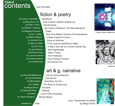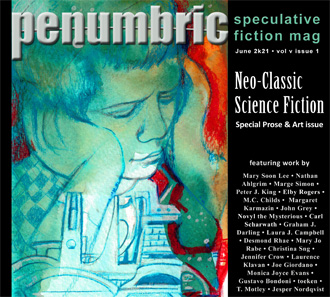From the Editor
by
Jeff Georgeson
previous next


full contents
Sycamore
From the Editor
by
Jeff Georgeson
previous

full contents
next

Sycamore
From the Editor
by
Jeff Georgeson
previous next


full contents
Sycamore
previous

full contents
next

Sycamore
From the Editor by Jeff Georgeson
From the Editor
by Jeff Georgeson
Back in the old times (yes, those early 00s when broadband was at least better than dial-up and phones were no smarter than bricks), Penumbric would, once a year, have an issue including only the work of its contributors—that is, no interviews, no article, just stories, poems, and art. Back then, admittedly, the art was a bit scarce, but there was more than enough prose to go round. (Plus the magazine was quite a bit shorter lol)
I've decided to revive this tradition, both to feature more works and, admittedly, to give myself a little recharge time after reintroducing myself to writing articles and doing interviews. This also opens up just a bit more space for acceptances, which I'm mindful of as we're reopening for prose submissions 15 June. More on that in a minute.
So what's in this issue? Is there a theme?
If you've looked at the cover you'll probably know that, whilst there isn't an article or interview tying things together, we're featuring a plethora of works that reminded us, in some fashion or other, of "classic" science fiction, but with today's sensibilities. Which, when I first was thinking of "classic," seemed an easy thing to define ... I mean, spaceships and aliens and invasions of Earth and funky futures, right? But then, that really still covers much of science fiction generally. So what specifically made "classic" science fiction classic?
I guess by "classic" I mean very roughly the Golden Age of scifi, that time when the stories were more about the science and less about the people that used it, but that feels both a little unfair (I mean, those stories did in fact have characters) and a little restrictive, as I don't mean only those works published prior to, say, 1959. I guess my idea of classic scifi is based on a very generalized idea of how the stories progressed. It's sort of like how I felt about Star Wars and Star Trek when I was a child. (Oh yes, I'm going there ... but mind you, I like both, with reservations.)
The first Star Wars felt to me an epic adventure film; it was full of action and stuff happening, but not deep into character development. Luke Skywalker follows the prototypical Hero's Journey, from zero to hero, and most of the people he encounters are merely bit players in this: the wise old man, the princess, the rogue, etc. It wasn't deeply political, it wasn't deep into character development. (Now, later Star Wars films--with some glaring exceptions--are much more than this; I'm talking from the perspective of 1977, when there was just the one.)
Star Trek, on the other hand, seemed like it was as much about the various characters as anything else. Even characters not in the "top three" could be developed; Sulu, Uhura, Chekov, and others all had at least some episodes that developed their characters. And the show delved into political and philosophical issues as well—albeit sometimes ridiculously ("Yangs" and "Coms," anyone?).
This is, of course, apples and oranges—a film doesn't have the time that a TV series has, and regardless a lot changed for these franchises as time went on. Star Wars as a franchise, after some hiccups, has gone on to have a lot more depth to its world and characters; Star Trek, after some hiccups, has also more deeply developed. In fact, a better comparison would be either of these franchises to itself over time; e.g., Star Trek went from a more action- and political commentary-oriented series to a much more philosophical and even more character-based series in Next Generation, continuing to morph through to Discovery (even while, oddly, replaying its own history, in some ways rewriting itself and "updating" the original characters to make them fit with modern sensibilities). But that would be getting into an entire set of essays ...
What makes the works in this issue of Penumbric "neo-classic"? They had this feel to us (OK, to me in particular) of the old-time scifi, of planets and worlds that could have been wrought by Asimov, Heinlein, LeGuin and the like, but while the settings could have been old-school, the characters, the people and not-people who inhabit them, felt more developed, more real, more ... now? We have journeys through space (and character) in Laura J. Campbell's "Sycamore" and Peter J. King's "Homecoming"; if you prefer to stay on one planet (or space station), try "If You Lead an Earthling to Water, Who Gets to Drink?" by Mary Jo Rabe, "Ruins on Korkhan" by Jennifer Crow, "Peter O'Toole" by Monica Joyce Evans, "Triage" by Margaret Karmazin, and "Form Follows Function" by Gustavo Bondoni. If your preferred planet is (what might be) Earth, go for Nathan Ahlgrim's "A Seed Crystal of Control," Laurence Klavan's "The Freelancer," and Joe Giordano's "Sibyl NIghtengale." We look at planetary/cosmic mysteries with Christina Sng in "The Eternal Fire" and Mary Soon Lee in "How to Mourn Kepler's Supernova," and we reposition our point-of-view in Graham J. Darling's "Jon Carver of Barzoon, You Misunderstood." We get strange with John Grey's "A Day in the Life of a Human Guinea Pig," and we look forward to our next issue with M.C. Childs' "Dear Post Master General of the Noosphere" (which is not exactly science fiction).
Our art this month follows a similar arc: We journey through the cosmos with Novyl the Mysterious' Cosmic Dance Aeternum, dance around the planets in Carl Scharwath's Oumuamua, head frighteningly close to the sun in Elby Rogers' Next Stop, the Sun, have a drink in Desmond Rhae's Pastoral and a lunch break in toeken's Lunch 2032 (Recharge), and move out to contemplate the universe again in Marge Simon's ad astra. Simon's work is also featured on our cover this month, with Tomorrow's Architect dreaming up some of these fantastic worlds.
Jesper Nordqvist continues to take us into the cyberpunky world of Mondo Mecho, whilst T. Motley whisks us through the ever-changing landscapes of The Road to Golgonooza in its penultimate episode.
After all that travelling, next issue will be a chance for us to just get our heads round it all (and we'll have another really cool interview!). And, for those looking to future themes (say, for submission purposes wink wink), in October we examine cyberpunk for the first time since the early 2000s, and beyond that we'll talk about virtual idols, art, and even possibly the use of AI in music (did you know Eurovision has an AI song contest?). We're also hoping to see more fantasy in our in-basket, and of course we'll be going back to horror because, well, we do that!
But for now ... enjoy this issue! And be well!
Jeff Georgeson
Managing Editor
Penumbric











